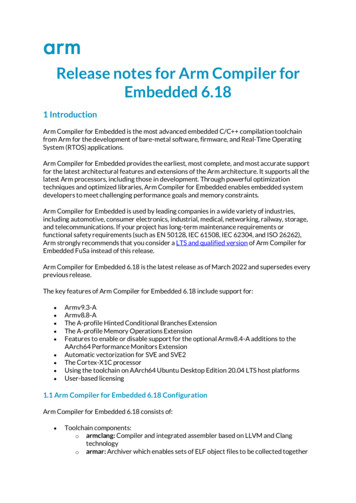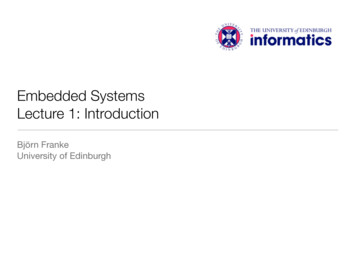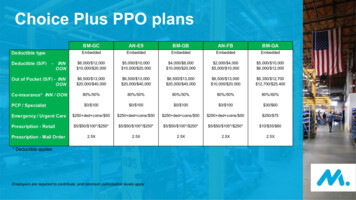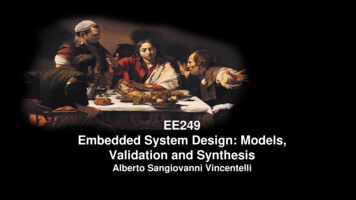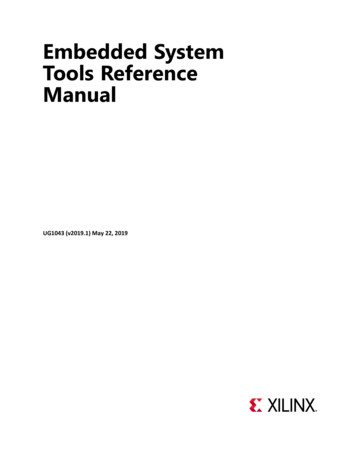
Transcription
Embedded SystemTools ReferenceManualUG1043 (v2019.1) May 22, 2019UG1043 (v2018.3) December 05, 2018
Revision History05/22/2019:Releasedwith Vivado DesignSuite for2019.1changes from 2018.3.The followingtable showsthe 12/05/2018 Version 2018.3General updatesMinor editorial changes.06/14/2016 Version 2016.2General updatesAdded information about the supported processors andcompilers.Added references to Zynq UltraScale MPSoC relateddocumentation.Embedded System Tools Reference Manual(v2018.3)MayDecember05, 2018UG1043 (v2019.1)22, 2019www.xilinx.comSend Feedback2
Table of ContentsRevision History . . . . . . . . . . . . . . . . . . . . . . . . . . . . . . . . . . . . . . . . . . . . . . . . . . . . . . . . . . . . . . . . . . . . 2Chapter 1: Embedded System and Tools Architecture OverviewDesign Process Overview. . . . . . . . . . . . . . . . . . . . . . . . . . . . . . . . . . . . . . . . . . . . . . . . . . . . . . . . . . . . 6Vivado Design Suite Overview . . . . . . . . . . . . . . . . . . . . . . . . . . . . . . . . . . . . . . . . . . . . . . . . . . . . . . . 8Software Development Kit . . . . . . . . . . . . . . . . . . . . . . . . . . . . . . . . . . . . . . . . . . . . . . . . . . . . . . . . . . 9Chapter 2: GNU Compiler ToolsOverview . . . . . . . . . . . . . . . . . . . . . . . . . . . . . . . . . . . . . . . . . . . . . . . . . . . . . . . . . . . . . . . . . . . . . . .Compiler Framework . . . . . . . . . . . . . . . . . . . . . . . . . . . . . . . . . . . . . . . . . . . . . . . . . . . . . . . . . . . . . .Common Compiler Usage and Options . . . . . . . . . . . . . . . . . . . . . . . . . . . . . . . . . . . . . . . . . . . . . . .MicroBlaze Compiler Usage and Options . . . . . . . . . . . . . . . . . . . . . . . . . . . . . . . . . . . . . . . . . . . . . .Arm Cortex-A9 Compiler Usage and Options. . . . . . . . . . . . . . . . . . . . . . . . . . . . . . . . . . . . . . . . . . .Other Notes . . . . . . . . . . . . . . . . . . . . . . . . . . . . . . . . . . . . . . . . . . . . . . . . . . . . . . . . . . . . . . . . . . . . .121214294648Chapter 3: Xilinx System DebuggerSDK System Debugger . . . . . . . . . . . . . . . . . . . . . . . . . . . . . . . . . . . . . . . . . . . . . . . . . . . . . . . . . . . . . 50Xilinx System Debugger Command-Line Interface (XSDB) . . . . . . . . . . . . . . . . . . . . . . . . . . . . . . . . 51Chapter 4: Flash Memory ProgrammingOverview . . . . . . . . . . . . . . . . . . . . . . . . . . . . . . . . . . . . . . . . . . . . . . . . . . . . . . . . . . . . . . . . . . . . . . . 52Program Flash Utility . . . . . . . . . . . . . . . . . . . . . . . . . . . . . . . . . . . . . . . . . . . . . . . . . . . . . . . . . . . . . . 53Other Notes . . . . . . . . . . . . . . . . . . . . . . . . . . . . . . . . . . . . . . . . . . . . . . . . . . . . . . . . . . . . . . . . . . . . . 55Appendix A: GNU UtilitiesGeneral Purpose Utility for MicroBlaze Processors. . . . . . . . . . . . . . . . . . . . . . . . . . . . . . . . . . . . . . 60Utilities Specific to MicroBlaze Processors. . . . . . . . . . . . . . . . . . . . . . . . . . . . . . . . . . . . . . . . . . . . . 60Other Programs and Files . . . . . . . . . . . . . . . . . . . . . . . . . . . . . . . . . . . . . . . . . . . . . . . . . . . . . . . . . . 63Appendix B: Additional Resources and Legal NoticesXilinx Resources . . . . . . . . . . . . . . . . . . . . . . . . . . . . . . . . . . . . . . . . . . . . . . . . . . . . . . . . . . . . . . . . . . 64Solution Centers. . . . . . . . . . . . . . . . . . . . . . . . . . . . . . . . . . . . . . . . . . . . . . . . . . . . . . . . . . . . . . . . . . 64Documentation Navigator and Design Hubs . . . . . . . . . . . . . . . . . . . . . . . . . . . . . . . . . . . . . . . . . . . 64Embedded System Tools Reference Manual(v2018.3)MayDecember05, 2018UG1043 (v2019.1)22, 2019www.xilinx.comSend Feedback3
References . . . . . . . . . . . . . . . . . . . . . . . . . . . . . . . . . . . . . . . . . . . . . . . . . . . . . . . . . . . . . . . . . . . . . . 65Training Resources. . . . . . . . . . . . . . . . . . . . . . . . . . . . . . . . . . . . . . . . . . . . . . . . . . . . . . . . . . . . . . . . 65Please Read: Important Legal Notices . . . . . . . . . . . . . . . . . . . . . . . . . . . . . . . . . . . . . . . . . . . . . . . . 66Embedded System Tools Reference Manual(v2018.3)MayDecember05, 2018UG1043 (v2019.1)22, 2019www.xilinx.comSend Feedback4
Chapter 1Embedded System and Tools ArchitectureOverviewThis guide describes the architecture of the embedded system tools and flows provided inthe Xilinx Vivado Design Suite for developing systems based on the MicroBlaze embedded processor and the Cortex A9, A53 and R5 Arm processors.The Vivado Design Suite system tools enable you to design a complete embeddedprocessor system for implementation in a Xilinx FPGA device.The Vivado Design Suite is a Xilinx development system product that is required toimplement designs into Xilinx programmable logic devices. Vivado includes: The Vivado IP integrator tool, with which you can develop your embedded processorhardware. The Software Development Kit (SDK), based on the Eclipse open-source framework,which you can use to develop your embedded software application. SDK is alsoavailable as a standalone program. Embedded processing Intellectual Property (IP) cores including processors andperipherals.For links to Vivado documentation and other useful information, see Appendix B,Additional Resources and Legal Notices.Embedded System Tools Reference Manual(v2018.3)MayDecember05, 2018UG1043 (v2019.1)22, 2019www.xilinx.comSend Feedback5
Chapter 1: Embedded System and Tools Architecture OverviewDesign Process OverviewThe tools provided with Vivado are designed to assist in all phases of the embedded designprocess, as illustrated in Figure 1-1.X-Ref Target - Figure 1-1HDL orSchematicVivadoAddEmbedded SourceSDKDesign Entry1. Create design in Base System Builder(automatically launches the first time)2. Modify design in System Assembly ViewCreate /Identify a Workspace(Automatic)Other Sources- RTL- Core Generator- System GeneratorCreate a New Project/BoardSupport PackageExport to SDK(.xml file only)Application DevelopmentImplementation to Bitstream1. Synthesis2. Translate3. MAP4. PAR5. Timing6. Bitstream Generation7. Data2MEM.elfDownload to FPGANetlist Generationwith Platgen.bit.mmiDebugExport to SDK(.xml, .bit, .mmi files )BoardFigure 1-1:Embedded Design Process FlowHardware DevelopmentXilinx FPGA technology allows you to customize the hardware logic in your processorsubsystem. Such customization is not possible using standard off-the-shelf microprocessoror controller chips.The term “Hardware platform” describes the flexible, embedded processing subsystem youare creating with Xilinx technology for your application needs.The hardware platform consists of one or more processors and peripherals connected to theprocessor buses.When the hardware platform description is complete, the hardware platform can beexported for use by SDK.Embedded System Tools Reference Manual(v2018.3)MayDecember05, 2018UG1043 (v2019.1)22, 2019www.xilinx.comSend Feedback6
Chapter 1: Embedded System and Tools Architecture OverviewSoftware DevelopmentA board support package (BSP) is a collection of software drivers and, optionally, theoperating system on which to build your application. The created software image containsonly the portions of the Xilinx library you use in your embedded design. You can createmultiple applications to run on the BSP.The hardware platform must be imported into SDK prior to creation of software applicationsand BSP.VerificationVivado provides both hardware and software verification tools. The following subsectionsdescribe the verification tools available for hardware and software.Hardware Verification Using SimulationTo verify the correct functionality of your hardware platform, you can create a simulationmodel and run it on an Hardware Design Language (HDL) simulator. When simulating yoursystem, the processor(s) execute your software programs. You can choose to create abehavioral, structural, or timing-accurate simulation model.Software Verification Using DebuggingThe following options are available for software verification: You can load your design on a supported development board and use a debugging toolto control the target processor. You can gauge the performance of your system by profiling the execution of your code.Device ConfigurationWhen your hardware and software platforms are complete, you then create a configurationbitstream for the target FPGA device. For prototyping, download the bitstream along with any software you require to run onyour embedded platform while connected to your host computer. For production, store your configuration bitstream and software in a non-volatilememory connected to the FPGA.Embedded System Tools Reference Manual(v2018.3)MayDecember05, 2018UG1043 (v2019.1)22, 2019www.xilinx.comSend Feedback7
Chapter 1: Embedded System and Tools Architecture OverviewVivado Design Suite OverviewAn embedded hardware platform typically consists of one or more processors, peripheralsand memory blocks, interconnected via processor buses. It also has port connections to theoutside world. Each of the processor cores (also referred to as pcores or processor IPs) has anumber of parameters that you can adjust to customize its behavior. These parameters alsodefine the address map of your peripherals and memories. IP integrator lets you select fromvarious optional features; consequently, the FPGA needs only implement the subset offunctionality required by your application.Figure 1-2 provides an overview of the Vivado architecture structure of how the toolsoperate together to create an embedded system.X-Ref Target - Figure 1-29LYDGR 6'.%,7 00, %00 %,7 )LOHV)LOHV1HZ 3URMHFW :L]DUG,PSRUW 'HVLJQ([SRUW 'HVLJQ WR 6'.6\QWKHVLV&UHDWH %63 SSOLFDWLRQ3ODFH DQG 5RXWH%XLOG (/) )LOH,PSRUW (/) )LOH%,7 00, %00 %,7 )LOHV)LOHV%LWVWUHDP *HQHUDWRU5H ,PSRUW 'HVLJQ([SRUW 'HVLJQ WR 6'. DUGZDUH 6RIWZDUH 0DQDJHU3URJUDP )3* JTAG Cable)3* 'HYLFH; Figure 1-2:Vivado Design Suite Tools ArchitectureEmbedded System Tools Reference Manual(v2018.3)MayDecember05, 2018UG1043 (v2019.1)22, 2019www.xilinx.comSend Feedback8
Chapter 1: Embedded System and Tools Architecture OverviewSoftware Development KitThe Software Development Kit (SDK) provides a development environment for softwareapplication projects. SDK is based on the Eclipse open-source standard. SDK has thefollowing features: Can be installed independent of Vivado with a small disk footprint. Supports development of software applications on single- or multi-processor systems. Imports the Vivado-generated hardware platform definition. Supports development of software applications in a team environment. Ability to create and configure board support packages (BSPs) for third-party OS. Provides off-the-shelf sample software projects to test the hardware and softwarefunctionality. Has an easy GUI interface to generate linker scripts for software applications, programFPGA devices, and program parallel flash memory. Has feature-rich C/C code editor and compilation environment. Provides project management. Configures application builds and automates the make file generation. Supplies error navigation. Provides a well-integrated environment for seamless debugging and profiling ofembedded targets.For more information about SDK, see the Software Development Kit (SDK) Help [Ref 1].Table 1-1:Software Development and Verification ToolsGNU Compiler ToolsBuilds a software application based on the platforms created.Xilinx System Debugger(XSDB)A command-line interface for hw server and other TCF servers.SDK System DebuggerGUI for debugging software on either a simulation model or targetdevice.Program Flash UtilityAllows you to erase and program on-board serial & parallel flash deviceswith software and data.Embedded System Tools Reference Manual(v2018.3)MayDecember05, 2018UG1043 (v2019.1)22, 2019www.xilinx.comSend Feedback9
Chapter 1: Embedded System and Tools Architecture OverviewGNU Compiler ToolsGNU compiler tools (GCC) are called for compiling and linking application executables foreach processor in the system. Processor-specific compilers are: The mb-gcc compiler for the MicroBlaze processor. The arm-none-eabi-gcc, arm-linux-gnu-eabihf-gcc,aarch64-linux-gnu-gcc, aarch64-none-eabi-gcc, armr5-none-eabi-gcccompilers for the Arm processor.As shown in the embedded tools architectural overview (Figure 1-2, page 8): The compiler reads a set of C-code source and header files or assembler source files forthe targeted processor. The linker combines the compiled applications with selected libraries and produces theexecutable file in ELF format. The linker also reads a linker script, which is either thedefault linker script generated by the tools or one that you have provided.Refer to Chapter 2, “GNU Compiler Tools,”, and Appendix A, GNU Utilities for moreinformation about GNU compiler tools and utilities.Xilinx System Debugger (XSDB)Xilinx System Debugger (XSDB) is a command-line interface for hw server and other TCFservers. XSDB interacts with the TCF servers, thereby providing a full advantage of thefeatures supported by the TCF servers.XSDB supports programming FPGAs, downloading and running programs on targets andother advanced features. Refer to Chapter 3, Xilinx System Debugger for more information.SDK System DebuggerThe Xilinx-customized System Debugger is derived from open-source tools and isintegrated with Xilinx SDK. The SDK debugger enables you to see what is happening to aprogram while it executes. You can set breakpoints or watchpoints to stop the processor,step through program execution, view the program variables and stack, and view thecontents of the memory in the system.The SDK debugger supports debugging through Xilinx System Debugger (XSDB). Refer toChapter 3, Xilinx System Debugger for more information.Note: The GDB flow is deprecated and will not be available for future devices. The System Debuggeris intended for use only with the Arm over Digilent cable.Embedded System Tools Reference Manual(v2018.3)MayDecember05, 2018UG1043 (v2019.1)22, 2019www.xilinx.comSend Feedback10
Chapter 1: Embedded System and Tools Architecture OverviewProgram Flash UtilityThe Program Flash utility is designed to be generic and targets a wide variety of flashhardware and layouts. See Chapter 4, “Flash Memory Programming.”Embedded System Tools Reference Manual(v2018.3)MayDecember05, 2018UG1043 (v2019.1)22, 2019www.xilinx.comSend Feedback11
Chapter 2GNU Compiler ToolsOverviewThe Vivado Design Suite includes the GNU compiler collection (GCC) for the MicroBlaze processor and the Cortex A9 processor. The Vivado GNU tools support both the C and C languages. The MicroBlaze GNU tools include mb-gcc and mb-g compilers, mb-as assembler andmb-ld linker. The Cortex A9 Arm processor tools include arm-xilinx-eabi-gcc andarm-xilinx-eabi-g compilers, arm-xilinx-eabi-as assembler, andarm-xilinx-eabi-ld linker. The toolchains also include the C, Math, GCC, and C standard libraries.The compiler also uses the common binary utilities (referred to as binutils), such as anassembler, a linker, and object dump. The MicroBlaze and Arm compiler tools use the GNUbinutils based on GNU version 2.16 of the sources. The concepts, options, usage, andexceptions to language and library support are described Appendix A, “GNU Utilities.”Compiler FrameworkThis section discusses the common features of the MicroBlaze andCortex A9Arm processorcompilers. Figure 2-1 displays the GNU tool flow.Embedded System Tools Reference Manual(v2018.3)MayDecember05, 2018UG1043 (v2019.1)22, 2019www.xilinx.comSend Feedback12
Chapter 2: GNU Compiler ToolsX-Ref Target - Figure 2-1Input C/C Filescpp0cc1cc1plusas(mb-as or arm-xilinx-eabi-as)ldLibraries(mb-ld or arm-xilinx-eabi-ld)Output ELF FileX13367Figure 2-1:GNU Tool FlowThe GNU compiler is named mb-gcc for MicroBlaze and arm-xilinx-eabi-gcc for ArmCores. The GNU compiler is a wrapper that calls the following executables: Pre-processor ( cpp0)This is the first pass invoked by the compiler. The pre-processor replaces all macroswith definitions as defined in the source and header files. Machine and language specific compilerThis compiler works on the pre-processed code, which is the output of the first stage.The language-specific compiler is one of the following: C Compiler ( cc1)The compiler responsible for most of the optimizations done on the input C codeand for generating assembly code.C Compiler ( cc1plus)The compiler responsible for most of the optimizations done on the input C code and for generating assembly code. Assembler (mb-as for MicroBlaze, arm-xilinx-eabi-as for Arm.The assembly code has mnemonics in assembly language. The assembler convertsthese to machine language. The assembler also resolves some of the labels generatedby the compiler. It creates an object file, which is passed on to the linker. Linker (mb-ld for MicroBlaze, arm-xilinx-eabi-ld for Arm.Links all the object files generated by the assembler. If libraries are provided on thecommand line, the linker resolves some of the undefined references in the code bylinking in some of the functions from the assembler.Embedded System Tools Reference Manual(v2018.3)MayDecember05, 2018UG1043 (v2019.1)22, 2019www.xilinx.comSend Feedback13
Chapter 2: GNU Compiler ToolsExecutable options are described in: Commonly Used Compiler Options: Quick Reference, page 18 Linker Options, page 23 MicroBlaze Compiler Options: Quick Reference, page 30 MicroBlaze Linker Options, page 37 Arm Cortex-A9 Compiler Usage and Options, page 46Note: From this point forward the references to GCC in this chapter refer tothe MicroBlaze compiler,mb-gcc ,and references to G refer tothe MicroBlaze C compiler, mb-g .Common Compiler Usage and OptionsUsageTo use the GNU compiler, type: Compiler Name options files.where Compiler Name is mb-gcc or arm-xilinx-eabi-gcc. To compile C programs,you can use the mb-g or arm-xilinx-eabi-g command.Input FilesThe compilers take one or more of the following files as input: C source files C source files Assembly files Object files Linker scriptsNote: These files are optional. If they are not specified, the default linker script embedded in thelinker (mb-ld or arm-xilinx-eabi-ld) is used.The default extensions for each of these types are listed in Table 2-1. In addition to the filesmentioned above, the compiler implicitly refers to the libraries files libc.a, libgcc.a,libm.a , and libxil.a. The default location for these files is the Vivado installationdirectory. When using the G compiler, the libsupc .a and libstdc .a files are alsoreferenced. These are the C language support and C platform libraries, respectively.Embedded System Tools Reference Manual(v2018.3)MayDecember05, 2018UG1043 (v2019.1)22, 2019www.xilinx.comSend Feedback14
Chapter 2: GNU Compiler ToolsOutput FilesThe compiler generates the following files as output: An ELF file. The default output file name is a.exe on Windows. Assembly file, if -save-temps or -S option is used. Object file, if -save-temps or -c option is used. Preprocessor output, .i or .ii file, if -save-temps option is used.File Types and ExtensionsThe GNU compiler determines the type of your file from the file extension. Table 2-1 liststhe valid extensions and the corresponding file types. The GCC wrapper calls theappropriate lower level tools by recognizing these file types.Table 2-1:File ExtensionsExtensionFile type (Dialect).cC file.CC file.cxxC file.cppC file.c C file.ccC file.SAssembly file, but might have preprocessor directives.sAssembly file with no preprocessor directivesEmbedded System Tools Reference Manual(v2018.3)MayDecember05, 2018UG1043 (v2019.1)22, 2019www.xilinx.comSend Feedback15
Chapter 2: GNU Compiler ToolsLibrariesTable 2-2 lists the libraries necessary for the mb gcc and arm-xilinx-eabi-gcc compilers.Table 2-2:Libraries Used by the CompilersLibraryParticularlibxil.aContain drivers, software services (such as XilMFS) and initialization files developedfor the Vivado tools.libc.aStandard C libraries, including functions like strcmp and strlen.libgcc.aGCC low-level library containing emulation routines for floating point and 64-bitarithmetic.libm.aMath Library, containing functions like cos and sine.libsupc .aC support library with routines for exception handling, RTTI, and others.libstdc .aC standard platform library. Contains standard language classes, such as those forstream I/O, file I/O, string manipulation, and others.Libraries are linked in automatically by both compilers. If the standard libraries areoverridden, the search path for these libraries must be given to the compiler. The libxil.ais modified to add driver and library routines.Language DialectThe GCC compiler recognizes both C and C dialects and generates code accordingly. ByGCC convention, it is possible to use either the GCC or the G compilers equivalently ona source file. The compiler that you use and the extension of your source file determines thedialect used on the input and output files.When using the GCC compiler, the dialect of a program is always determined by the fileextension, as listed in Table 2-1, page 15. If a file extension shows that it is a C sourcefile, the language is set to C . This means that if you have compile C code contained in aCC file, even if you use the GCC compiler, it automatically mangles function names.The primary difference between GCC and G is that G automatically sets the defaultlanguage dialect to C (irrespective of the file extension), and if linking, automaticallypulls in the C support libraries. This means that even if you compile C code in a .c filewith the G compiler, it will mangle names.Name mangling is a concept unique to C and other languages that support overloadingof symbols. A function is said to be overloaded if the same function can perform differentactions based on the arguments passed in, and can return different return values. Tosupport this, C compilers encode the type of the function to be invoked in the functionname, avoiding multiple definitions of a function with the same name.Embedded System Tools Reference Manual(v2018.3)MayDecember05, 2018UG1043 (v2019.1)22, 2019www.xilinx.comSend Feedback16
Chapter 2: GNU Compiler ToolsBe careful about name mangling if you decide to follow a mixed compilation mode, withsome source files containing C code and some others containing C code (or using GCCfor compiling certain files and G for compiling others). To prevent name mangling of a Csymbol, you can use the following construct in the symbol declaration.#ifdef cplusplusextern “C” { endifint foo();int morefoo();#ifdef cplusplus} endifMake these declarations available in a header file and use them in all source files. Thiscauses the compiler to use the C dialect when compiling definitions or references to thesesymbols.Note: All Vivado drivers and libraries follow these conventions in all the header files they provide.You must include the necessary headers, as documented in each driver and library, when youcompile with G . This ensures that the compiler recognizes library symbols as belonging to “C”type.When compiling with either variant of the compiler, to force a file to a particular dialect, usethe -x lang switch. Refer to the GCC manual on the GNU website for more information onthis switch. A link to the document is provided in the Appendix B, “Additional Resources andLegal Notices.” When using the GCC compiler, libstdc .a and libsupc .a are not automaticallylinked in. When compiling C programs, use the G variant of the compiler to make sure allthe required support libraries are linked in automatically. Adding -lstdc and -lsupc to the GCC command are also possible options.For more information about how to invoke the compiler for different languages, refer to theGNU online documentation.Embedded System Tools Reference Manual(v2018.3)MayDecember05, 2018UG1043 (v2019.1)22, 2019www.xilinx.comSend Feedback17
Chapter 2: GNU Compiler ToolsCommonly Used Compiler Options: Quick ReferenceThe summary below lists compiler options that are common to the compilers for MicroBlazeand Arm processors.Note: The compiler options are case sensitive.To jump to a detailed description for a given option, click its name in the table below.General OptionsLibrary Search Options-E-Wp,option-l libraryname-S-Wa,option-L Lib Directory-c-Wl,option-g-helpHeader File Search Option-gstabs-B directory-I Directory Name-On-L directory-v-I directory-save-temps-l libraryLinker Options-defsym STACK SIZE value-defsym HEAP SIZE value-o filenameGeneral Options-EPreprocess only; do not compile, assemble and link. The preprocessed output displays onthe standard out device.-SCompile only; do not assemble and link. Generates a .s file.-cCompile and Assemble only; do not link. Generates a .o file.-gThis option adds DWARF2-based debugging information to the output file. The debugginginformation is required by the GNU debugger, mb-gdb or arm-xilinx-eabi-gdb. Thedebugger provides debugging at the source and the assembly level. This option addsdebugging information only when the input is a C/C source file.Embedded System Tools Reference Manual(v2018.3)MayDecember05, 2018UG1043 (v2019.1)22, 2019www.xilinx.comSend Feedback18
Chapter 2: GNU Compiler Tools-gstabsUse this option for adding STABS-based debugging information on assembly (.S) files andassembly file symbols at the source level. This is an assembler option that is provideddirectly to the GNU assembler, mb-as or arm-xilinx-eabi-as. If an assembly file iscompiled using the compiler mb-gcc or arm-xilinx-eabi-gcc, prefix the option with -Wa.-OnThe GNU compiler provides optimizations at different levels. The optimization levels in thefollowing table apply only to the C and C source files.Table 2-3:Optimizations for Values of nnOptimization0No optimization.1Medium optimization.2Full optimization3Full optimization. Attempt automatic inlining of small subprograms.SOptimize for size.Note: Optimization levels 1 and above cause code re-arrangement. While debugging your code, useof no optimization level is recommended. When an optimized program is debugged through gdb,the displayed results might seem inconsistent.-vThis option executes the compiler and all the tools underneath the compiler in verbosemode. This option gives complete description of the options passed to all the tools. Thisdescription is helpful in discovering the default options for each tool.-save-tempsThe GNU compiler provides a mechanism to save the intermediate files generated duringthe compilation process. The compiler stores the following files: Preprocessor output -input file name.i for C code and input file name.iifor C code Compiler ( cc1) output in assembly format - input file name.s Assembler output in ELF format - input file name.sThe compiler saves the default output of the entire compilation as a.out.Embedded System Tools Reference Manual(v2018.3)MayDecember05, 2018UG1043 (v2019.1)22, 2019www.xilinx.comSend Feedback19
Chapter 2: GNU Compiler Tools-o filenameThe compiler stores the default output of the compilation process in an ELF file nameda.out . You can change the default name using -o output file name. The output file iscreated in ELF format.-Wp,option-Wa,option-Wl,optionThe compiler, mb-gcc or arm-xilinx-eabi-gcc, is a wrapper around other executables suchas the preprocessor, compiler (cc1), assembler, and the linker. You can run thesecomponents of the compiler individually or through the top level compiler.There are certain options that are required by tools, but might not be necessary for thetop-level compiler. To run these commands, use the options listed in the following table.Table 2-4:Tool-Specific Options Passed to the Top-Level GCC gcc -Wp,-D -Wp, MYDEFINE .Signal the pre-processor to define the symbol MYDEFINEwith the -D MYDEFINE option.-Wa,optionAssemblermb-as -Wa, .Signal the assembler to target the MicroBlaze processor.-Wl,optionLinkermb-gcc -Wl,-M .Signal the linker to produce a map file with the -M option.-helpUse this option with any GNU compiler to get more information about the availableoptions. You can also consult the GCC manual.-B directoryAdd directory to the C run time library search paths.-L directoryAdd directory to library search path.-I directoryAdd directory to header search path.Embedded System Tools Reference Manual(v2018.3)MayDecember05, 2018UG1043 (v2019.1)22, 2019www.xilinx.comSend Feedback20
Chapter 2: GNU Compiler Tools-l librarySearch library for undefined symbols.Note: The compiler prefixes “lib” to the library name indicated in this command line switch.Library Search Options-l librarynameBy default, the compiler searches only the standard libraries, such as libc, libm, andlibxil. You can also create your own libraries. You can specify the name of the library andwhere the compiler can find the definition of these functions. The compiler prefixes lib tothe library name that you provide.The compiler is sensitive to the order in which you provide options, particularly the -lcommand line switch. Provide this switch only after all of the sources in the command line.For example, if you create your own library called libproject.a. you can include functionsfrom this library using the following command:Compiler Source Files -L {LIBDIR} -l projectCAUTION! If you supply the library flag -l library name before the source files, the compiler does not findthe functions called from any of the sources. This is because the compiler search is only done in one directionand it does not
Embedded System Tools Reference Manual 7 UG1043 (v2018.3) December 05, 2018 www.xilinx.com Chapter 1:Embedded System and Tools Architecture Overview Software Development A board support package (BSP) is a collection of software drivers and, optionally, the operating system on which to build your application. The created software image contains







